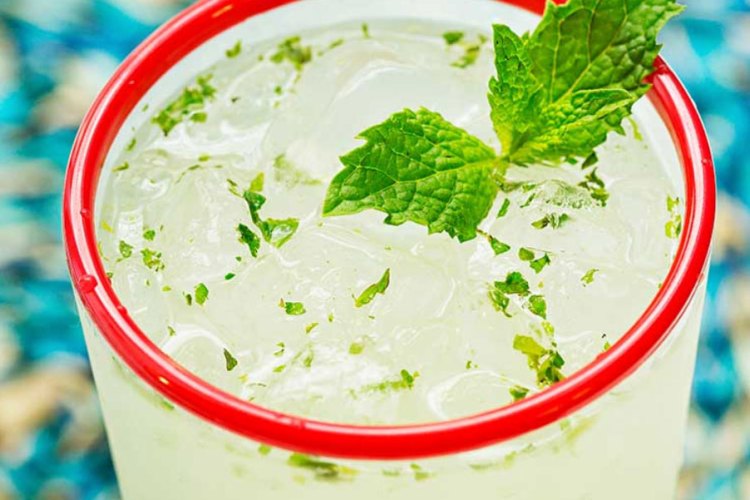
In honor of Absinthe Day (March 5), we’d like to suggest a novel way to celebrate: cocktails, with absinthe front and center.
Turns out the anise-flavored spirit’s not only misunderstood on its own — no, sipping it won’t make you hallucinate — but also as a component of stirred and shaken drinks. If you’re only used to drinking absinthe with a sugar cube or as a rinse for a Sazerac, you’ve been missing out on the green spirit’s cocktail potential.
To learn about absinthe-forward cocktails, we spoke with Alan Moss, an absinthe company owner (La Clandestine, which offers 200ml bottles that are ideal if you’re just using absinthe as a rinse or a mixer), brand ambassador and a Tales of the Cocktail seminar leader on the anise-flavored spirit. He’s also the brains behind The Real Absinthe Blog, an indispensable online resource on all things related to “la fée verte” (the green fairy) since 2007. And we also took green knowledge from Laura Bellucci, the Bar Director at New Orleans’s Belle Epoque, an absinthe-forward cocktail lounge in the courtyard of the legendary Old Absinthe House.
“Absinthe has a long history in cocktails,” notes Ballucci. “Jerry Thomas popularized the use of absinthe in cocktails as early as the 1870s. His books had recipes for ‘improved cocktails.’ Improved often included the addition of liqueurs and citrus and, of course, absinthe.”
Sorry, start from the beginning. What is absinthe?
Absinthe is an anise-flavored spirit that dates back to the canton of Neuchâtel in Switzerland in the late 18th century. It’s often green but not always, and the spirit is often associated with trippy visuals, bohemian writers and hallucinogenic qualities. Because of that last (misguided) characteristic, several countries (including the United States and most of Europe) banned the spirit for nearly a century.
What Is Absinthe Day?
An American creation that marks the legalization of real absinthe in 2007. The day is actually March 1 in Switzerland, the green spirit’s country of origin. “I’ve been suggesting bars combine these days to make Absinthe Week,” says Moss. (If you want to experience a full week of green fairy glory, head to Brasserie du Parc in Houston, which runs an absinthe program from the beginning of the month through March 7th.)
Historically, has absinthe been a popular ingredient in cocktails?
The first commercial absinthe distillery opened in Switzerland in 1798. The same year, the first documented reference to a “cocktail” appeared in the London Morning Post and Gazetteer. So, yes. “Apparently, cocktails and absinthe were paired at birth,” says Moss. And the iconic Savoy Cocktail Book from 1930 features 108 recipes with absinthe.
What ingredients go well with absinthe?
Moss used the Savoy Cocktail Book and 2010’s A Taste for Absinthe to crunch some numbers; over the years, bartenders have increasingly paired absinthe in cocktails with sugar/simple syrup and lemon/lime. And while its use in absinthe cocktails has decreased, gin is still a popular complementary spirit. “The similar use of botanicals is probably a factor,” says Moss.
“Since absinthe is typically grape-based, it definitely plays well with grape-based spirits like vermouth, sherry and wine,” says Bellucci. “And rum is great with absinthe. Fruity, rich, and tropical modifiers like creme de coco, coconut rum, apricot liqueur, etc. Chareau, an aloe and cucumber liqueur, feels like it was made just to play with absinthe. As far as non-boozy ingredients? Honey, tropical fruit, berries and fresh herbs.”
The late Gary Regan (The Joy of Mixology) found absinthe worked well with almost everything. “Apart from the fact that it pairs so well to both Scotch and to mezcal — both known for their smoky characters — absinthe, when used judiciously, can bring fabulous nuances to cocktails that can be gotten from no other source,” he wrote in 2014.
So when does absinthe not do well in a cocktail?
“You have to be careful with extremely aggressive spirits like Campari and mezcal, because they can mute out the botanicals in absinthe entirely,” says Ballucci. “But like all things, it is a balancing act.”
While not being against their use, Moss notes that vodka and tequila make very rare appearances in cocktail books when discussing absinthe.
What cocktails should you make with absinthe?
For Moss, it’s a Bloody Mary variation called the Bloody Fairy, and a play on the Caipirinha called the Clandestino (made with La Clandestine, natch). But he truly loves the Absinthe Eggnog.
1.5 oz La Clandestine
1.5 oz heavy/double cream
.75 oz simple syrup
.5 oz vanilla extract
1 egg
Combine in a shaker and first shake without ice. Add one cup ice, shake vigorously for 30 seconds. Pour in glass, grate fresh nutmeg over the top and garnish with star anise.
For Bellucci, she suggests starting slow: the Sazerac and Corpse Reviver, which have an absinthe rinse (aka coating the inside of a glass with absinthe and then discarding it prior to making the cocktail). “It’s a nice subtle introduction to the aromas of absinthe.” From there, try tiki cocktails, which use absinthe as a “supportive, secondary note.”
As for a recipe, she gives us the Une Correspondence, a reference to a connecting train ticket to Cherenton … a well-known insane asylum in the suburbs of Paris.
1.5 oz Vieux Carre Absinthe
.5 oz Bernards Honey
.5 oz lemon juice
Handful fresh mint
Splash club soda
Gently muddle honey, lemon, and mint at the bottom of a Collins glass, add absinthe, rocks, roll in shaker with ice, dump into rocks glass and top with soda.
This article was featured in the InsideHook newsletter. Sign up now.
